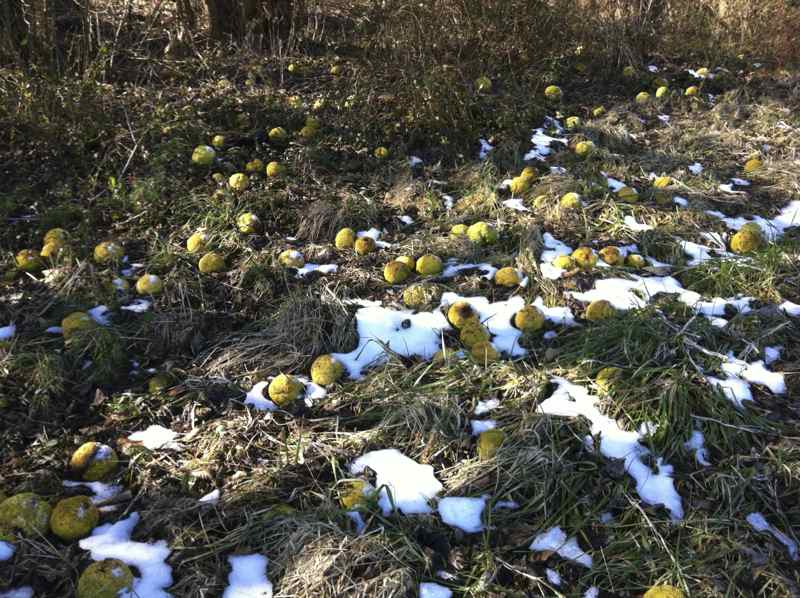Bicycle Botany: Road Marbles, Part Two
 Russell Rogers Posted on
Russell Rogers Posted on  Tuesday, January 22, 2013 at 9:05PM
Tuesday, January 22, 2013 at 9:05PM  In part one of Road Marbles we learned that humans were not the first of earth's organisms to engage in chemical warfare. Plants were probably in need of a Geneva Convention long before animals ever showed up on the scene. Osage orange also has interesting chemical properties…or not.
In part one of Road Marbles we learned that humans were not the first of earth's organisms to engage in chemical warfare. Plants were probably in need of a Geneva Convention long before animals ever showed up on the scene. Osage orange also has interesting chemical properties…or not.
A common story that floats around is that placing an Osage orange under your bed or in your basement would repel spiders and insects from your house. There are even websites today that sell Osage orange touting it just for that purpose. However, there is not a lick of science to back up that claim. Plus, why would you want to drive away spiders? Spiders are a surefire way to get ride of insects in your house! Osage orange does contain a chemical, elemol, that has been shown to be as effective at repelling insects as DEET. However, the chemical has to be extracted and refined from the fruit for it to be effective. Here is a website that talks about the myth of Osage orange repellent.
 An other myth around about Osage orange is their edibility. Some say that is, some say that they are but why bother, and most (overwhelming majority, including myself) say they are not. My reasoning is that zillions of these things fall to the ground around here and remain there until they rot and turn to a putrid mush (see right). If they were edible I would think some animal would eat them. Plus, who in their right mind would eat something that could also repel and kill insects. We'll just leave it at that.
An other myth around about Osage orange is their edibility. Some say that is, some say that they are but why bother, and most (overwhelming majority, including myself) say they are not. My reasoning is that zillions of these things fall to the ground around here and remain there until they rot and turn to a putrid mush (see right). If they were edible I would think some animal would eat them. Plus, who in their right mind would eat something that could also repel and kill insects. We'll just leave it at that.
Chemical and food issues aside, the thing that I find most interesting about Osage orange is that it is native alien. Yes, a native alien. Osage orange is a native tree of North America. However, it's natural range is fairly restricted, confined to eastern Texas, and small portions of Oklahoma and Arkansas. It's current range extends across nearly the entirety of North America. It is particularly common in the east and midwest.
 The primary reason for this distribution is cattle. Not because cows eat the orange and the distribute the seeds in cow pies (a process know as endozoochory). Nor do the seeds stick the cows fur and fall off in some distant spot later (a process know as epizoochory). Nope. Osage orange has sharp thorns on their branches and can grow in thick hedges that cows cannot pass through. Humans planted these trees far and wide to keep cows close to home. But as it turns out, metal fence post and barbed wire was cheaper and could be put into use fairly quick as there was no waiting around for that fence to grow.
The primary reason for this distribution is cattle. Not because cows eat the orange and the distribute the seeds in cow pies (a process know as endozoochory). Nor do the seeds stick the cows fur and fall off in some distant spot later (a process know as epizoochory). Nope. Osage orange has sharp thorns on their branches and can grow in thick hedges that cows cannot pass through. Humans planted these trees far and wide to keep cows close to home. But as it turns out, metal fence post and barbed wire was cheaper and could be put into use fairly quick as there was no waiting around for that fence to grow.
It was also planted widely as a windbreak in the Great Plains and other places. It was such a popular plant for hedges and windbreaks that FDR incorporated it into his New Deal program called the "Great Plains Shelterbelt." This WPA project set out to stop the dust bowl and change the climate. Really. They planted 220 million trees for this project, most of them Osage orange.
Osage orange was also prized by Native Americans as the best wood to fashion bows from. It was such a valuable resource for them that wars were fought between tribes for control of lands where the tree grew. I'm thinking the Osage Tribe was pretty popular amongst Native nations. The bows sure were, as they have been found as far as 2000 miles away from native Osage orange range.
The uses of this tree are many and I could go on and on. It is clearly a plant that humans value and admire. Except for me. I hate the darn things. These oranges are large and when they first fall off the tree they are pretty hard. When the 23 mm wide front wheel of an expensive road bike meets one of these unexpectidly, the chances that you will become a road marble are suddenly increased to a troubling level!
Ride lots, stop often, and avoid road marbles!
Russell

Reader Comments